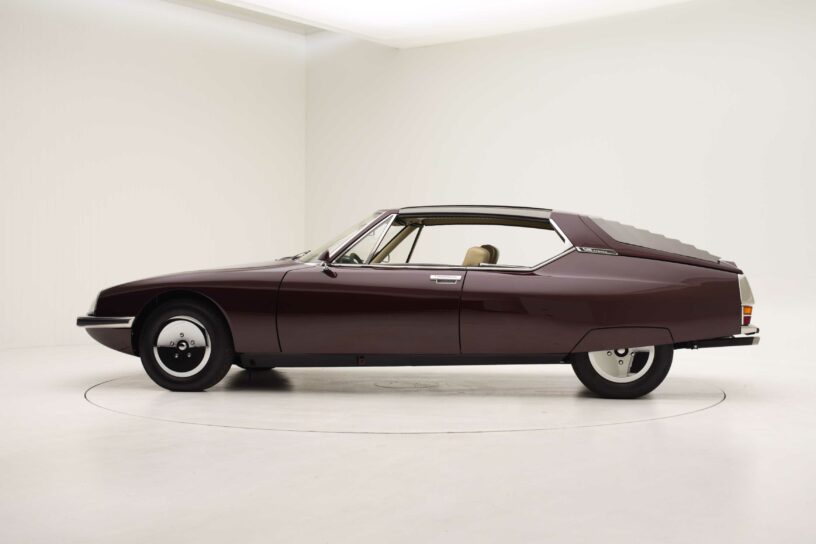Few car makers have innovated like Citroën, and the three models which Salon Privé will bring together on Blenheim’s South Lawn later this month perfectly illustrate how much the historic French company’s designers and engineers were tasked with lateral thought when integrating sometimes complex and advanced features into their products.
1971 Citroën SM Espace
Sometimes true innovation – even when its patented – lacks the commercial appeal needed to make production a reality. Such was the case when French coachbuilder Heuliez created a clever and quite striking open-topped version of the already ground-breaking Citroën SM.
The SM had launched in 1970, the result of a short-lived alliance between Citroën and Maserati that ended in 1974. Even in standard guise, the SM was something to behold, incorporating much of the advanced technology already seen in the DS model, such as all-round self-levelling suspension and hydro-pneumatic springs, but combined with Maserati mechanicals. With its rakish, futuristic styling it cut a swathe through everything else on the market, underscored by the bark from its wide-angled, Italian V6 engine. The 2670cc unit was derived from Maserati’s existing V8, and even after the SM finished production, went on to be used in the mid-engined Merak supercar.
However, Salon Privé’s car is quite unique. Essentially, a convertible SM, the Espace used a central T-bar running between its windscreen header and rear-cabin to offer structural reinforcement, while serving as a conduit for slatted roof ‘lamellar’ sections that would retract inwards to provide open-topped motoring. The design was complemented by horizontal louvres – a la Lamborghini Miura – that ran across the SM’s long rear screen, polished-alloy wheel covers, a cream leather interior and green leather dashboard covering. The car’s exterior was painted in a deep Aubergine, and one can only imagine the stir it would have caused at Paris’s Salon de l’Automobile in 1971 when it made its debut.
After a second appearance at the Brussels Motor Show the following year, in which significant trim changes were made inside the car, and the rear louvres and alloy wheel covers removed, Citroën decided not to take up the option of productionising the car, and Heuliez retained it to demonstrate the now-patented technology to other potential buyers. Despite a second push to attract interest from US manufacturers in 1978, the SM Espace – now painted Delta Blue – failed to garner any further orders.
In 2012, the Espace was sold at an Artcurial auction to Denis Joannon, a former Citroën dealer, who fully recommissioned the car, and fitted modified hubs to accept Resine (GRP) wheels, that would have been optional equipment on the SM when it was new. After appearing at the 2015 Chantilly Concours and Rétromobile in 2018, the SM Espace was once again sold, this time to Thierry Dehaeck. The following year, Dehaeck, working closely with Yves Dubernard, who had been chief engineer on the project in 1971, brought the car back to its original Paris Salon specification, restoring the louvres and original Aubergine paintwork, among other features. The work was completed in February 2021.
“It’s such a shame that the SM Espace never reached production,” said Andrew Bagley, Salon Privé’s Chairman. “It incorporated patented technology that was never adopted in the motor industry and could well have changed the fortunes of Heuliez. All the same, I’m delighted this car still exists; it perfectly encapsulates Salon Privé’s focus on the rare and sometimes outrageous parts of the car world.”
1963 Citroen 2CV Sahara
The 2CV’s reasons for being are well-known: to provide basic, durable, cheap mobility for French farmers, who were still wedded to the notion of a horse and cart as their everyday transport. Launched in 1948, the 2CV fulfilled its remit perfectly, but there were still customers for whom the deux-chevaux didn’t quite go far enough.
With France having mining and oil interests in North Africa, there became a need in the 1950s for an inexpensive and ultra-reliable vehicle that could hold its own in desert conditions. The aptly named 2CV Sahara was Citroën’s retort, and it demonstrated the company’s ability to find alternative solutions to otherwise costly and complex demands. By fitting the 2CV’s 425cc air-cooled twin-cylinder engine in, not just the front, but the rear of the car, Citroën provided users with instant four-wheel-drive, but also the back-up of a ‘spare’ engine should one unit fail. Each engine used slightly larger carburettors and its own four-speed gearbox, but both were operated by a common clutch.
Produced between 1958 and 1971, the Sahara was a great success, its reliability and near-ideal weight distribution making it a boon in hostile desert environments (it was said to be capable of traversing 45-degree inclines). Salon Privé’s lovingly restored 1963 example first saw service with France’s Service de Forestier, before being bought by a collector in the early ‘80s. After his death, the Sahara was bequeathed to his gardener, who in turn sold it to another collector in 2007. Still retaining its original chassis, the car underwent a full restoration, preserving as many body panels as possible, and returning its paintwork to the original Embrun Green. The car changed hands a further two times – first at an event to mark the 50th anniversary of the Sahara in 2008, and then again in 2016 – before being bought by its current owner at Citroën’s centenary celebrations in France in 2019.
Andrew Bagley, Salon Privé’s Chairman, is looking forward to seeing the 2CV Sahara in such esteemed company: “Who other than Citroën would come up with such an innovative method of delivering drive to all four wheels? This model is testament to the lateral thinking of its engineers, and while it almost looks like any other 2CV from a distance, almost every component and body panel is unique to the Sahara. We’re lucky to be hosting such a superb example, too: of the near-700 Saharas produced, only 27 are thought to survive, so this will be a rare treat for Salon Privé’s guests.”
Citroen DS 23 Pallas IE (Injection Electronique)
Few car launches in automotive history have been as memorable as that for the Citroën DS in 1955. When it was unveiled at the Paris Salon on October 6th that year, within 45 minutes, 749 orders had been placed. And by the end of the day, Citroën had taken a further 11,000.
It wasn’t hard to see why, either. Replacing the aged ‘Traction Avant’ models launched more than two decades before, the DS was not just a step, but a giant leap into the future, that arguably advanced technology across the entire motor industry. Sculptor Falminio Bertoni had created a shape that looked like something from outer-space, with its low, tapered, aerodynamic design. And Citroën engineer André Lefèvre had devised a chassis the likes of which nobody had seen before, combining front-wheel-drive, self-levelling suspension all round, as well as high-pressure hydro-pneumatic springs at each corner, which could be raised by the driver from inside the car to help traverse uneven terrain or wade through floods.
Salon Privé’s DS 23 was built in 1974, the model’s penultimate year of production before it was replaced by the CX. As such, not only does it incorporate all the myriad revisions that occurred through the DS’s two-decade life, but being a range-topping Pallas version it’s fitted with standard items, like the swivelling headlamps that were connected to the steering, the light beams projecting around corners.
“Nearly one-and-a-half million DSs and ID models were produced between 1955 and ’75,” said Andrew Bagley, Salon Privé’s Chairman. “The car we’re hosting at Blenheim Palace represents the very pinnacle of that production lineage, and as a recently restored car, will give audiences an appreciation of just how radical its design was, even in its final years.”
With a programme that includes Ladies’ Day presented by Boodles on Friday, the Salon Privé Club Trophy presented by Lockton on Saturday, and Sunday’s Classic and Supercar event, all the elements are in place for another unmissable Salon Privé Week.
*Article Source http://www.salonpriveconcours.com/








